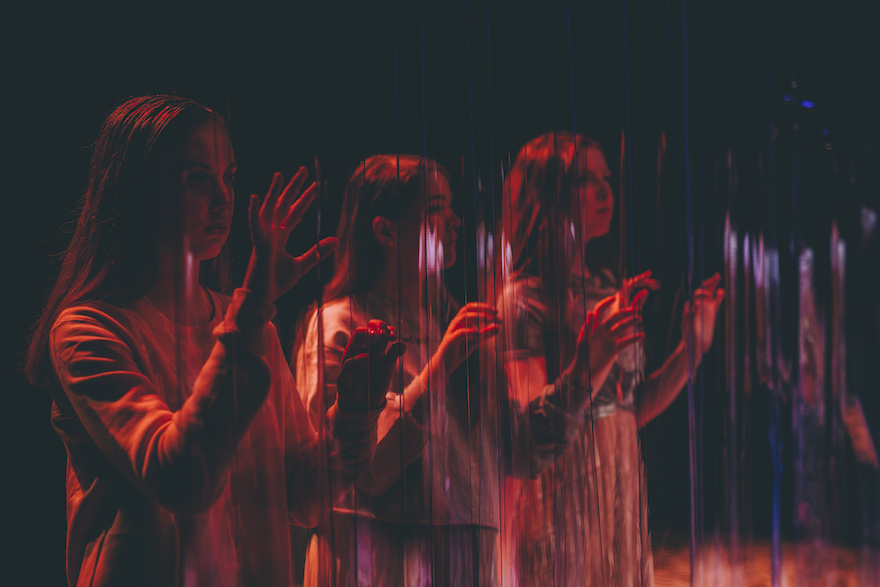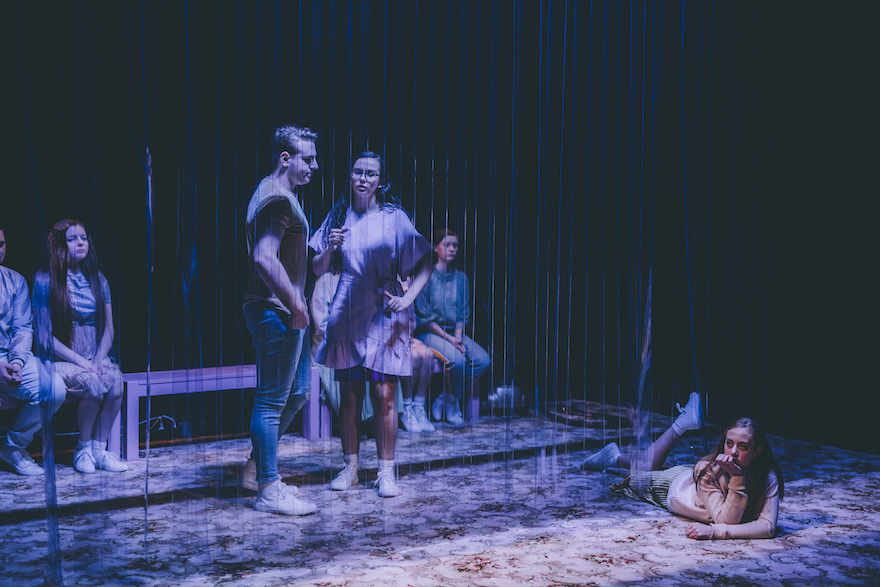Review: Riptide, The 1s and 0s and Everything in Between ·
Mandurah Performing Arts Centre, 18 September ·
Review by Xan Ashbury ·
This play left me feeling incredibly uplifted. Sure, communication in the digital age is fraught with issues and it’s unlikely to get any less complicated in the future. What warmed my heart was a glimpse at the future of theatre.
I’m embarrassed to admit that before seeing this show, I imagined theatre by young people as something you politely endured rather than enjoyed. I imagined a mediocre script rendered awkward by enthusiastic but untrained performers. Well, the joke’s on me.
Everything about this production, directed by Katt Osborne, was brilliant – from the poignant, funny and shockingly relatable script (by Chris Isaacs) and clever set (Laura Heffernan), to the innovative staging and flawless performances. It shows what is possible when young people’s talent is harnessed and nurtured. It shows what is possible when new writing is commissioned and funding is made available for a professional dramaturg, designer and director.
We are connected – but are we close? This is the central question explored in The 1s and 0s and Everything in Between. A series of vignettes examine relationships, conversations and the construction of identity in the age of digital communication.

The key feature of Heffernan’s set is integral to the play. Strips of thick transparent plastic, forming a curtain, divide the stage: the front half representing the “real” world, and the rear half the digital world – the world we experience behind the screen of our smartphone or computer.
At one point, the performers tapped in unison on the screen, saying “dot dot dot”. It made me reflect on that rush of dopamine I feel when checking into Messenger or Hangouts to find someone I love composing a message. (“Wavy dots” I call them. I usually type “wavy”, just so they know I am there, too, and am feeling that delicious sense of anticipation.)
Often, performers just behind the screen interact with those in a scene in the “real”, highlighting how hyper-connection hinders our efforts to be truly present or augments our perception of reality.
In one scene, a man and women on a Tinder date look at messages on their phones. Each has a friend (behind the screen) checking in on them, asking for updates. When both gave bogus explanations for having to reply to the message, the audience erupted with knowing laughter. “Yes! I do that all the time!” my friend whispered to me.
In fact, my ribs were sore by the end of the show, not just from laughing so often but by the number of times my companion had nudged me with her elbow – shorthand for: That is us, that has been us, or we were just talking about that the other day…

There are scenes about virtue signalling, ridiculous hashtags, inane comment threads, catfishing and anonymity fuelling hateful comments. Scenes about long-distance lovers, finding it hard find anything to say, beyond “I love you” and “I miss you”, highlight the primacy of physical connection. We witness another couple, whose relationship is strained by smartphone addiction, particular the fear of missing out. A budding actor discovers she is more valued for her Instagram following than her talent.
In one scene, young women talk up the freedom of being able to select a date from the comfort of their home, dressed in their jammies. In previous eras, women had to dress up to meet the male gaze, then go out and be harassed by men, they said. At the end of scene, they pose provocatively, trying to capture the right look for their profile photos. Clearly, we are meant to recognise that while there is some truth in what they believe, they are naive to think they have escaped the pressures of objectification.
My one slight criticism is that I felt the play was a little too long. It covered a multitude of scenarios which arise out of our relationships with technology; but I think trimming or cutting several of these would enhance rather than detract from the audience’s overall experience.
The Riptide ensemble, based in Mandurah, is comprised of Max Baker, Ruby Liddelow, Teaghan Lowry, Harrison Mitchell, Tristan Pateman, Clea Purkis, Lexie Sleet, Monique Tibbott, Shekaila Walker and Megan Willis. While all were magnificent, Purkis deserves a special mention – she was an exceptional.
The ensemble worked with Isaacs (an award-winning WA playwright), giving their thoughts and opinions on communication and how technology affects the way we connect with each other. This helps to explain why their performances appeared so natural and authentic; it was a case of their youth being an asset rather than a hurdle. I sincerely hope it can be restaged to a new and bigger audience.
Pictured top: Max Baker and Clea Purkis. Photo: Zal Kanga-Parabia.
Read more about Riptide in an interview with Katt Osborne.
Like what you're reading? Support Seesaw.






